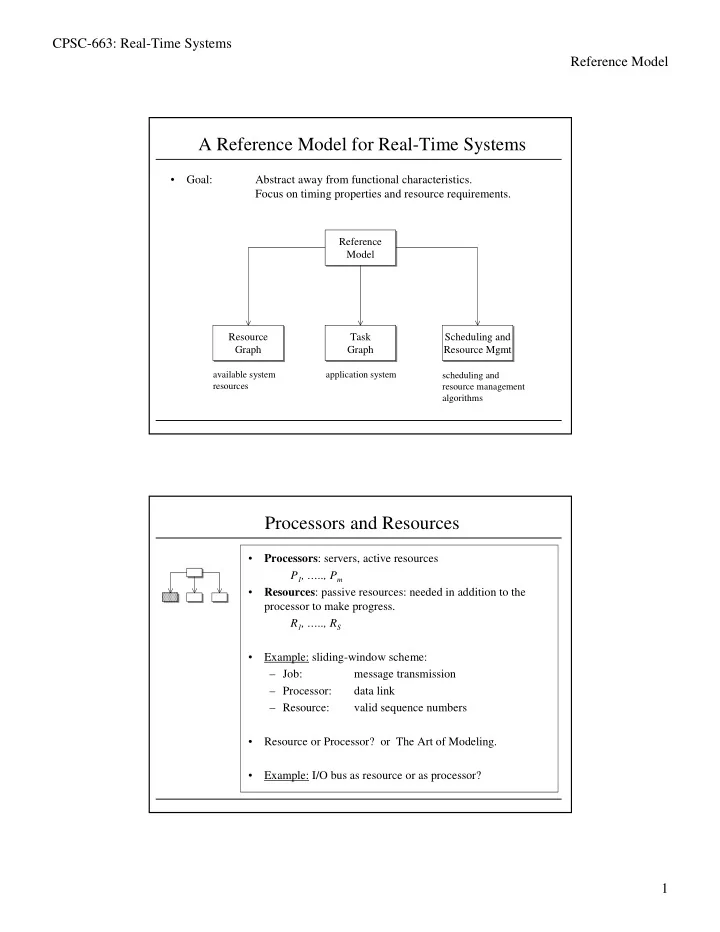

CPSC-663: Real-Time Systems Reference Model A Reference Model for Real-Time Systems • Goal: Abstract away from functional characteristics. Focus on timing properties and resource requirements. Reference Reference Model Model Resource Task Scheduling and Resource Task Scheduling and Graph Graph Resource Mgmt Graph Graph Resource Mgmt available system application system scheduling and resources resource management algorithms Processors and Resources • Processors : servers, active resources P 1 , ….., P m • Resources : passive resources: needed in addition to the processor to make progress. R 1 , ….., R S • Example: sliding-window scheme: – Job: message transmission – Processor: data link – Resource: valid sequence numbers • Resource or Processor? or The Art of Modeling. • Example: I/O bus as resource or as processor? 1
CPSC-663: Real-Time Systems Reference Model Temporal Parameters • J i : Job ; unit of work • T j : Task , set of related jobs. e.g. Periodic task is sequence of invocations of identical jobs. • r i : Release time of Job J i • d i : Absolute deadline of Job J i • D i : Relative deadline of Job J i • e i : (Maximum) execution time of Job J i Q : Why do we use maximum execution time? 1. Variations of execution times typically small. 2. Unclaimed portion of time and resources can be used for soft real-time portions. The Periodic Task Model • Tasks T 1 , ….., T n • Each task consists of jobs : T i = {J i1 , J i2 , …….} φ • : Phase of T i i • p i : Period of T i : minimum inter-release time • H : Hyperperiod H = lcm(p 1 , ….., p n ) • e i : Execution time of T i • u i : Utilization of T i u i = e i /p i • D i : (Relative) deadline of T i , typically D i = p i 2
CPSC-663: Real-Time Systems Reference Model Aperiodic and Sporadic Tasks • Capture unexpected events • A(x) : Interarrival time distribution • B(x) : Execution time distribution • Definitions: – Aperiodic tasks: Jobs have either soft or no deadlines. – Sporadic tasks: Jobs have hard relative deadlines. Precedence Constraints / Precedence Graph • Reflects data and control dependencies • e.g. Consumer/Producer in radar system: signal track processing association • Precedence relation < (partial order) Ji < Jj : Ji is predecesor of Jj • Precedence graph: G = (J, <) • Precedence constraints can be quite exotic, e.g. AND/OR: all predecessors only some predecessors AND OR must complete must complete • Not all dependencies can be captured by task graphs: e.g. access to shared data – imposed by scheduling algorithm 3
CPSC-663: Real-Time Systems Reference Model Functional Parameters • Preemptivity: – Preemption : Suspension of execution of job to give processor to more urgent job. – Preemptable: e.g. job on CPU, message in packet- switched network – Non-preemptable: data frame in token ring – Non-preemptability is typically tied to particular resource: Job still preemptable on other resources. – What is the cost of preemption? • Criticalness: – Can associate weight with jobs to indicate criticalness with respect to other jobs. – Schedulers and resource access protocols then optimize weighted performance measures. Schedules and Scheduling Algorithms • Schedule : assignment of jobs to available processors • Feasible schedule : In a feasible schedule, every job starts at or after its release time and completes by its deadline. • Optimality of a scheduling algorithm: A scheduling algorithm is optimal if it always produces a feasible schedule if such a schedule exists. • Performance measures: – Number of tardy jobs. – Maximum or average tardiness . – Maximum or average absolute lateness – Maximum or average response time – Makespan 4
Recommend
More recommend